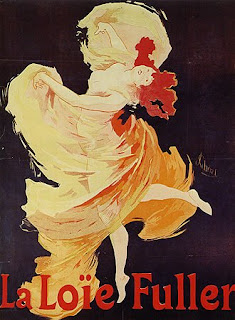
Fuller's work gained much attention in her time primarily because it was so very different from the classical ballet that had previously been the only widely accepted dance form. Her work attracted the attention of poet Stephane Mallarme, Marie Curie (whose home she performed at), and French author and dramatist Alexandre Dumas, as well as serving as the inspiration for many pieces of poetry. Lithographs, prints, and statues of her image were created (as the one seen at right, created in 1901 by Francois-Raoul Larche, currently residing in the Museum of Modern Art). Fuller's theatrical lighting and costuming was partially inspired by the vaudeville and burlesque shows she performed in at a young age, so some elements of the spectacle that was also popular in ballet can be seen in her pieces. She also used classical music by such major composers as Mozart, Schubert, and Debussy, and this use of popular music can be seen as well in Isadora Duncan's performances to symphonies by Beethoven and Tchaikovsky. Fuller was able to translate the growing trend of curving, flowing, natural lines into her movement, and her conversion of nature into movement reflected the growing art nouveau trend in society at the time. Her influence can still be seen in recreations of her pieces by such dancers and choreographers as Jody Sperling, whose company
Time Lapse Dance is partially focused on Fuller-inspired works (website and clips of her work can be found at http://www.timelapsedance.com/). Multiple books have been written on Fuller and her life and style, including the memoir published by Fuller herself in 1908, entitled "Quinze Ans de Ma Vie", or "Fifteen Years of My Life" (later republished in English and called "Fifteen Years of A Dancer's Life").
Clare de Lune, Inspired by Fuller, Performed by Jody Sperling, 2008
http://www.youtube.com/watch?v=qmppvqRzeP4






